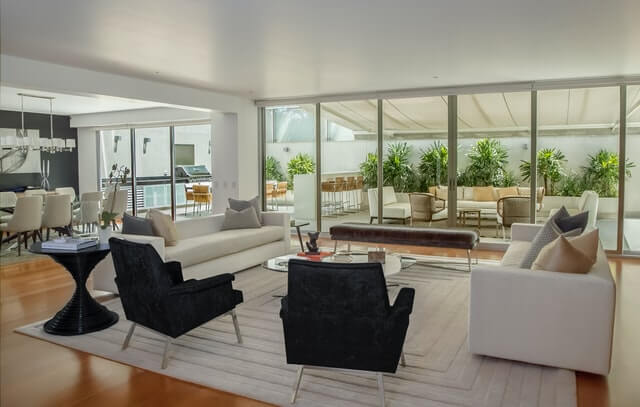Virtual staging is when a real estate agent can use technology to create a presentation or walk-through of a property for potential buyers. This allows the agent to control the presentation and helps buyers feel more confident about purchasing.
There are many benefits to virtual staging, including saving time and money. Additionally, it can increase the chances of a sale by giving buyers an idea of their home’s appearance before they see it.
But is that all to it? Is it really necessary to have virtually staged property for sale? Is it worth it? What are the cons, and how much does it cost?
Don’t worry; all your burning questions are answered in this post. Continue reading to find out everything you need to know about virtual staging.
Page Contents
What Is Virtual Staging?
You’ve probably seen virtually staged rooms on the internet without realizing it.
Virtual staging is the practice of digitally adding furniture and decor to an image of the property to enhance the value and appeal of a home.
Leading virtual staging companies uses 3D software and gaming technology to make the different furniture look as if it were real. Because of this, only a few virtual staging companies use designers with real experience to build the area.
Consumers can more easily envision the possibilities of a space or property thanks to computer-generated images of a virtually staged home. Unfortunately, most buyers cannot appreciate a house’s potential until they have seen it in person.
Virtual staging may help buyers see a space’s size, function, and potential as a residence.
6 Advantages Of Virtually Staging Real Estate Property
Virtual home staging is one of the best ways to sell it quickly and for the most money.
It’s important to stage a home so potential buyers can see it in its best light, and you can do this with little cost and effort. However, since first impressions are important in real estate, it’s not surprising that staging has become an important part of selling.
Customers are told to pay more attention than usual to how a house is built instead of how it looks inside and outside. For example, when clutter, old furniture, and many personal items that belong to the current owners are displayed in the listing photos and during showings, it can be hard to sell a home.
Staging is a great way to help potential buyers see a place’s full potential, which can be very helpful for you as a seller.
Here are some obvious benefits of virtual staging real estate:
Virtually Staged Properties Sell Faster For More Money.
By 1 to 5 percent, buyers’ agents said staging increased the asking price. However, 22% of sellers’ agents concur, and 17% believe the price rose by 6% to 10%.
Only 1% of buyers’ and 0% of sellers’ agents agreed that staging decreased the offer price. There’s nothing to lose and a lot to gain by staging an event. Houses with distinctive interior design features need to keep in mind.
25% of sellers’ agents report a substantial decrease in the days a staged property is on the market. However, only 12% of the seller’s agents claimed that staging did not affect the days a home was on the market.
Staging aids buyers in determining whether or not they can see themselves in a home and all of the possibilities it offers. Asking them to do all the mental work is less productive.
It Showcases The Highlights And Full Potential Of The Intended Space Use Of The Property.
The home must be more appealing to potential buyers while on the market.
83% of buyers’ agents feel that arranging a property makes it easier for buyers to see themselves living there. For example, as reported by buyers’ agents, 38% of those who saw a house online were more inclined to see it in person once it was staged.
When selling a property, staging is an excellent approach to attract prospective buyers. It is feasible to design a home to appeal to a broad range of consumers, even though it is impossible to anticipate everyone’s preferences.
According to the NAR, Staging isn’t as critical in all spaces. For example, 47% of buyer’s agents say customers prefer staging a living room. 19% of buyers’ agents say the same about bathrooms and 8% about guest bedrooms.
Here’s some good news for sellers who can’t afford a full staging. Knowing which rooms are crucial (after the living room, the next three are the main bedroom, the kitchen, and the dining room) enables sellers to stage selected places to make the most effect with the least amount of labor while avoiding rooms that don’t matter much.
It Saves The Cost Of Laborsome Real Staging.
When compared to the expense of traditional ways of preparing a property for its sale, the price of virtual staging is, quite literally, a minuscule fraction of that cost.
Virtual staging does not need the removal of any items from home. However, getting rid of old furniture and replacing it with new furniture may incur many costs in traditional home staging.
Compared to the average cost of real staging, which is $6,000, virtual staging costs only $29 per shot.\
Virtual Staging Saves Time Over Real Staging.
Imagine how long it takes to replace old furniture and new furniture to be brought in and set?
The time and effort that goes into real staging can be cut short by more than half with virtual staging.
At Revepix, it takes 12-24 hours for the virtual staging to be done and prepared for the property listing advertising.
You Get Limitless Possibilities For Online Interior Designs.
You can appeal to and attract different people with different interior designs of the same property. For example, you can showcase the potential of the intended space of the property in different lights and angles.
The people who like minimalistic designs may take the similarly fashioned interior more interesting than the people who like classic interiors with pieces with elaborate decoration, sometimes with a floral or fauna influence, and well-made furniture with inlay carved or turned legs.
You get unlimited options for presentations of your property with virtual staging that would not be possible with real staging without breaking your bank and breaking a few bones, possibly with all the heavy lifting of the furniture.
Virtual Staging Is Legal And Appreciated By Potential Buyers.
According to a survey by the National Association of Realtors (NAR), 74 percent of real estate agents believe that purchasers already know what they want in a dream house before they start looking.
Buyers may find it difficult to understand how a property meets their expectations if it is not staged, but staged residences make it easier for buyers to see how they can change the space into what they desire.
For example, only 6% of respondents said staging a home had no effect on most consumers’ impressions, while 40% said it did.
Learn more on our comparison between virtual staging and real staging here.
How Does Virtual Staging Work?
Virtual staging is a way to improve digital pictures by adding furniture to a house picture using the same graphics software used for 3D movies.
As with traditional staging, beds and sofas, wall hangings, and carpets can be used.
When you take a picture of an empty room, it might look bigger or smaller than it is. Virtual staging is a great alternative for realtors because it lets them show the space and the room after being staged in the same picture. Potential buyers can see everything in the space, like the air vents, power outlets, and light switches.
Traditional things like painting, repairs, maintenance, and small changes are always needed when getting a house ready to sell. Buyers can see the house as if they had decorated it with Virtual Staging.
The same goes for personal things in the home, like pictures, worn couches, and trinkets. However, you also want to give it a style to make it your own.
Buyers can get a better idea of how their new furniture will look in a room by looking at photos before and after it has been set up. Real estate agents may help make viewings less stressful by making it easier for people to understand what will fit in a space.
What Are The Things Home Owners Should Know About Virtual Staging Real Estate?
If you’ve decided to stage your home visually, you should do a few things before giving your pictures to a graphic designer.
- Get your house in order.
It’s important to clean any part of your home that will be in a virtually staged photo, whether you’re staging an empty room or just switching out the furniture. The more empty and bright a place is, the easier it is to change it.
- Take off any personal items.
Clean up your room so that your designer doesn’t have to. This will save time and money on design, and there will be no need to worry about personal information or important papers being stolen. You can also hide valuables like jewelry boxes or safes by taking them out of the photographed area.
- Make small changes to your home.
To get rid of photographic evidence of wear and tear, make small changes to the house, such as fixing chipped paint or buffing hardwood floors. This will ensure that your room’s pictures are accurate and that buyers won’t be surprised when they come to see your house in person.
- Don’t forget the yard and outside.
Like home staging, curb appeal can make your home worth more—in this case, by about 20 percent. So please clean up the yard while getting your house ready to make it look better from the street. After all, you never know when a buyer will find the almost-finished photos online and ask to take a tour in person.
- Take photos with a high resolution.
We recommend hiring a professional photographer to take the photos your graphic designer will eventually stage. Still, you might be able to do it yourself if you know how to take photos and have ideas about how to light a virtual set. But a bad shot could ruin the whole thing, so quality is important.
Technology is changing the way people buy things, and if you’re trying to sell your house, you may be able to use digitally improved design to your advantage.
Virtually Staging A Home Requirements
Staging a house electronically is more than just adding a few pieces of furniture; it requires excellent photography and experienced interior designers. You need these two factors to achieve the greatest results from Virtual Staging:
Professional Images – Professional Images are the most accurate representation of reality. Virtually all staged homes have employed high-quality professional images as a starting point. For the furniture to appear realistic, high-resolution pictures are required. Photos taken by professional photographers may also show off the finest perspectives for staging, such as showing off more floor space in empty spaces.
Images to Consider – If you can’t visit a house in person, it’s difficult to tell what design would work best. While BoxBrownie.com has a wide choice of styles (Modern/Contemporary, Urban/Industrial, Scandinavian, and Farmhouse), it is best to share photographs of the furniture and style you want when sharing photos to be staged. Then, our editors can strive to replicate it as closely as possible.
Additionally, it may be helpful to sketch on one of the reference photographs where the furniture should be positioned or offer a detailed explanation of where it should be. For example, the flow of space might be difficult to discern if there are no visible doors, as editors often don’t know what is behind the photographer.
Managing Rooms That Are Only Partially Furnished
Virtual staging allows you to work with existing furnishings in the home, making it more versatile. Images that have been virtually staged but don’t include furniture tend to seem more realistic than photos.
On the other hand, Virtual Staging is a great way to add a few finishing touches to a space, such as artwork on the wall or a couple of tables. If the present furniture is modern or reflects the style you want the rooms to be staged in, we recommend doing this.
Why Hire Revepix as your Virtual Staging Company?
If you are looking for a team of experts in real estate when hiring a staging company, Revepix is the place for you! We have been in the real estate industry for over 7 years, arming ourselves with the experience and skills in technology and trends to help properties sell faster.
The typical cost of virtual staging is between $60 and $150 per image. We are selling it for $49. Please do not hesitate to contact us at Revepix if you have any queries.



